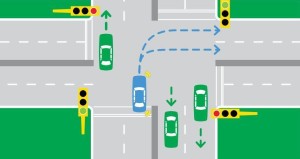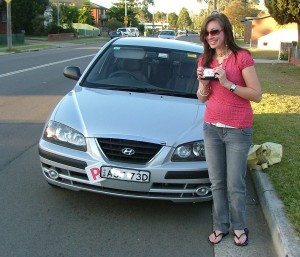Passed his driving test at Mount Druitt today
Hey cameron thanks for all your help !! Just letting you know that i did pass and if it weren’t for your lesson i would have failed miserably !! Thanks again

Professional Safe Reliable Over 15 Years Experience
Hey cameron thanks for all your help !! Just letting you know that i did pass and if it weren’t for your lesson i would have failed miserably !! Thanks again
A text
“Hi Cameron,
I finally passed !
!09 score
Thank you so much for being so patience and nice
You are amazing.
Jeanne.

Traffic lights When turning right at traffic lights:
Enter the intersection as shown in the diagram, unless a sign indicates otherwise
or there is a red right turn arrow displayed.
Wait until oncoming traffic clears or breaks and then turn safely.
If the lights change to yellow or red while you are in the middle of the intersection, you are allowed to turn right.
You must turn as soon as it is safe to do so. Be sure your front wheels and car are straight and not blocking the oncoming traffic.
Hi Cameron,
This is Lydia, I had a lesson on Tuesday and
did my test this morning. Just wanted to let you know I
passed !!!!
Thankyou for your lesson and You Tube Video I would not
have passed without it and I will get some lessons booked
for my sister later this month, thanks again.
Based On The NSW Guide To The Driving Test. guide-to-driving-test
Blind spots checks are also known as head checks and shoulder checks.
If you miss three blind spot checks on your driving test you will probably fail. So every time your blinker is blinking check the appropriate blind spot. Every time.
You must turn your head and check your blind spots before:
• Changing lanes.
• Leaving or returning to the kerb.
Before leaving the kerb, blink for at least 5 seconds and the very last thing before you move your car is a blind spot check.
Returning to the kerb, check your left blind spots.
• Merging or diverging.
• Reversing.
Before reversing, check three mirrors and both blind spots, looking mainly over your left shoulder out the back window while reversing.
• Turning left – looking for pedestrians, bicycles and motorcycles that could be
beside you in your blind spot.
Every time you turn left, blink and check your left blind spot – well before the turn. NOT during the left turn.
• Turning right – looking for vehicles that may be overtaking you.
Before making any right turn, check your right blind spot, looking for cars, bikes etc overtaking you on the right.
You can do the check as you approach the right turn or just before the turn.
• Joining the traffic stream.
• Leaving the inside lane of a multi lane roundabout.
When you are on the inside or right lane check your LEFT blind spot as you leave the roundabout. You are making sure the traffic in the left lane is not going to turn in front of you.
On your driving test slow down for roundabouts and then you will time to blink left when leaving plus check your blind spot.
When reversing you must turn your head and look over your shoulder to check
through the rear window for vehicles and pedestrians that may not be visible
in your mirror. All vehicles have blind spots behind.
Any questions please call or contact me. If you want to book a driving lesson please call. 0438 364 244
Make sure you pass driving test by reading and understanding The Guide To The Driving Test” The following is based on this booklet.
DISOBEYING TRAFFIC SIGNS, SIGNALS OR ROAD MARKINGS
Be sure you have a thorough understanding of the meaning of regulatory signs, traffic signals and road markings.
They tell you what road rules apply in any specific situation. Examples of this fail item include:
• Not stopping at a red traffic light.
This means that all of your vehicle must be behind the stop line.
– Be very careful when stopping at lights, your car must be behind the first or often only line. If any of your car is over the stop/first line you will fail your driving test.
• Not stopping at a yellow traffic light when it is safe to do so.
You must stop at a yellow light unless sudden braking might cause a crash.
– An amber lights means you must stop if it is safe to do so.
If you are being tailgated by a retard you can continue through the intersection because it is not possible to stop safely.
If you are very close to the stop line you can continue but remember that you must stop if you can safely do so.
• Not stopping correctly at a stop line.
Your final stopped position must be within one metre of the stop line and with no part of your car over the line.
– At a stop sign intersection be careful that you approach the stop line slowly and that
your car is behind the line BUT within one metre of the line.
• Crossing a continuous centre line, lane line or edge line unnecessarily.
– Avoid all solid white lines. If you drive over or on a line you will fail your driving test.
They are a few exceptions – getting into a left turning lane at an intersection with lights and if you need to overtake a stopped vehicle and this means crossing a solid line. Make sure you understand these exceptions.
• Disobeying lane markings (transit lane, turn arrows etc).
• Not obeying regulatory signs such as One Way, No Entry, No U-Turn,
Keep Clear and Keep Left.
Pass driving test first time and be a safe driver. Any questions about how to pass driving test call Cameron 0438 364 244
To make sure you pass driving test book a few driving lessons, Call Cameron 0438 364 244
[cy] Camber Drivng School Cameron Latta 34 Nathan Cres Dean Park, NSW, Australia
There are two overlooked things that are really important for your RMS driving test.
Refer to the “The Guide To The Driving Test” and make sure your understand this
Before proceeding through traffic lights, you must turn your head and check to ensure there are no vehicles that may be ‘running’ the red light, or pedestrians crossing against the ‘don’t walk’ sign. You must also turn your head and check to ensure it is safe before proceeding across a railway level crossing.
Therefore BEFORE you enter an intersection with traffic lights you MUST turn your head and look right and left. If you do not do this you will fail. Even if there is no road on your left or right you still must turn your head. Cos you need to look for pedestrians as well as bikes, cars, trucks etc.
The other overlooked thing is blind spots checks. Simply, every time a blinker is blinking there is a blind spot to check. Every time you change direction, as in turn left, you must indicate your intention and check the blind spot.
You must turn your head and check your blind spots before:
• Changing lanes.
• Leaving or returning to the kerb.
• Merging or diverging.
• Reversing.
• Turning left – looking for pedestrians, bicycles and motorcycles that could be beside you in your blind spot.
• Turning right – looking for vehicles that may be overtaking you.
• Joining the traffic stream.
• Leaving the inside lane of a multi lane roundabout.
When reversing you must turn your head and look over your shoulder.
On your RTA driving test you must do all blind spot checks because if you miss three you will fail. And you will be grumpy plus have to redo the RTA driving test.
When going through multi-lane roundabouts slow it down so you can blink left to leave the roundabout plus check your left blind spot if you are in the right lane. On my video page have a look at the three videos, may help you pass your driving test. Good Luck !

Any questions about your RMS driving test, call Cameron 0438 364 244
[cy] Camber Drivng School Cameron Latta 34 Nathan Cres Dean Park, NSW, Australia